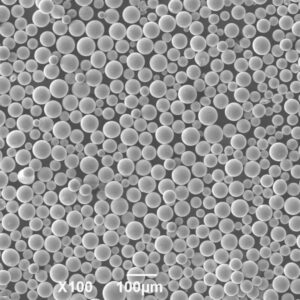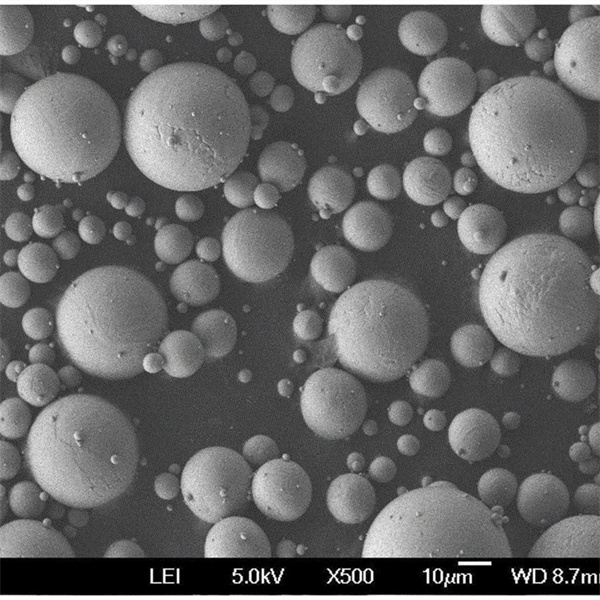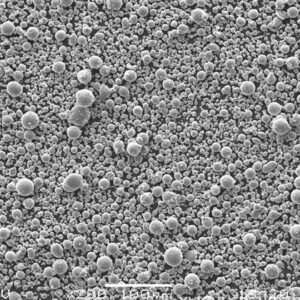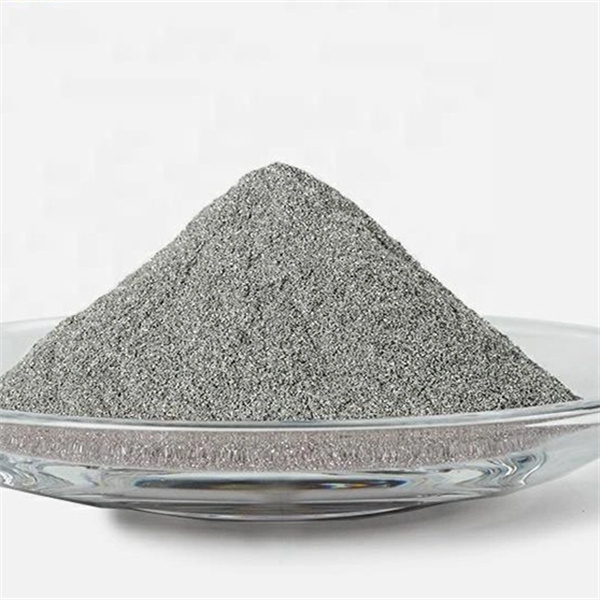ผง cusn10
ผง CUSN10 เป็นโลหะผสมทองแดงดีบุกที่มีดีบุกประมาณ 10% และทองแดงที่เหลือ มันมีการผสมผสานที่ยอดเยี่ยมของความแข็งแรงความเหนียวความต้านทานการกัดกร่อนความต้านทานการสึกหรอและคุณสมบัติการต้านการต้าน
Low MOQ
Provide low minimum order quantity to meet different needs.
OEM & ODM
Provide customized products and design services to meet unique customer needs.
Adequate Stock
Ensure fast order processing and provide reliable and efficient service.
ความพึงพอใจของลูกค้า
ให้ผลิตภัณฑ์ที่มีคุณภาพสูงด้วยความพึงพอใจของลูกค้าที่แกนกลาง
แบ่งปันผลิตภัณฑ์นี้
สารบัญ
Overview of CuSn10 Powder
ผง CUSN10 เป็นโลหะผสมทองแดงดีบุกที่มีดีบุกประมาณ 10% และทองแดงที่เหลือ มันมีการผสมผสานที่ยอดเยี่ยมของความแข็งแรงความเหนียวความต้านทานการกัดกร่อนความต้านทานการสึกหรอและคุณสมบัติการต้านการต้าน
Key properties and applications of CuSn10 powder include:
CuSn10 Powder Properties and Characteristics
| คุณสมบัติ | รายละเอียด |
|---|---|
| องค์ประกอบ | 90% copper, 10% tin |
| ความหนาแน่น | 8.8 g/cc |
| รูปร่างอนุภาค | ผิดปกติเชิงมุม |
| ช่วงขนาด | 5-150 microns |
| ความหนาแน่นที่ชัดเจน | มากถึง 50% ของความหนาแน่นจริง |
| ความสามารถในการไหลได้ | ปานกลาง |
| ความแข็งแกร่ง | Excellent for Cu alloy powder |
| ความเหนียว | ดี |
| ความต้านทานการกัดกร่อน | ดีมาก |
CuSn10 is widely used in bearing cages, bushings, welding rods, and wear parts across the automotive, electrical, and industrial sectors.
CuSn10 Powder Composition
Typical composition of CuSn10 powder:
CuSn10 Powder Composition
| องค์ประกอบ | น้ำหนัก % |
|---|---|
| ทองแดง (Cu) | Remainder |
| ดีบุก (SN) | 9-11% |
| Lead (Pb) | 0.2% max |
| สังกะสี (Zn) | สูงสุด 0.5% |
| Other impurities | สูงสุด 0.1% |
- Copper provides excellent conductivity, corrosion resistance, ductility
- Tin improves strength, hardness, and wear resistance
- Lead, zinc, and other impurities carefully controlled
The optimized Cu-Sn ratio provides an excellent combination of strength, ductility, and manufacturability.

CuSn10 Powder Physical Properties
CuSn10 Powder Physical Properties
| คุณสมบัติ | ค่า |
|---|---|
| ความหนาแน่น | 8.8 g/cc |
| จุดหลอมเหลว | 1020-1040°C |
| การนำความร้อน | 55 W/mK |
| ความต้านทานไฟฟ้า | 7-9 μΩ-cm |
| Recrystallization temperature | 150-250°C |
| อุณหภูมิการบริการสูงสุด | 250 ° C |
- Density is higher than copper
- Melting point reduced compared to pure copper
- Maintains good conductivity
- Recrystallization enables powder compaction
- สามารถทนต่ออุณหภูมิการทำงานที่สูงพอสมควร
The physical properties allow use of CuSn10 in electrical components needing good conductivity and strength.
CuSn10 Powder Mechanical Properties
CuSn10 Powder Mechanical Properties
| คุณสมบัติ | ค่า |
|---|---|
| ความแข็ง | 80-110 HB |
| แรงดึง | 350-550 MPa |
| ความแข็งแรงของผลผลิต | 220-320 MPa |
| การยืดตัว | 10-20% |
| โมดูลัสของความยืดหยุ่น | 110-140 GPa |
- Excellent strength for a copper alloy powder
- Significantly higher than pure copper powder
- Good ductility for 10% tin composition
- Hardness values suitable for wear applications
- Properties depend on production method and porosity
The mechanical properties allow use of CuSn10 powder in high strength electrical and friction components.
CuSn10 Powder Applications
Typical applications of CuSn10 powder include:
CuSn10 Powder Applications
| อุตสาหกรรม | ตัวอย่างแอปพลิเคชัน |
|---|---|
| เกี่ยวกับยานยนต์ | Bearings, bushings, brake linings |
| Electrical | Welding electrodes, connectors, contacts |
| ทางอุตสาหกรรม | Bearing cages, seals, impellers |
| การผลิต | Sintered tooling components |
| น้ำมันและก๊าซ | Bushings, ball valves |
การใช้ผลิตภัณฑ์เฉพาะบางอย่าง:
- Bearing cages requiring antifriction properties
- Bushing and thrust washers in high load applications
- Automotive brake pads and clutch linings
- Electrical connectors and pins
- Welding rods and solder paste filler metal
- Piping components like valves and flanges
Its excellent combination of strength, ductility, and cost make CuSn10 a popular choice for these applications.
CuSn10 Powder Specifications
The main specifications for CuSn10 powder include:
CuSn10 Powder Specifications
| มาตรฐาน | คำอธิบาย |
|---|---|
| ISO 44001 | Copper and copper alloy powders – Specifications |
| ASTM B602 | Standard specification for copper alloy powders |
| EN 1982 | Specification for copper and copper alloys ingots and castings |
| JIS H2111 | Bronze powders |
These define:
- ขีด จำกัด องค์ประกอบทางเคมี
- Production method – atomization
- Required physical and mechanical properties
- ระดับความบริสุทธิ์ที่ยอมรับได้
- การกระจายขนาดอนุภาค
- Testing protocols
Compliance ensures suitability for intended applications across global markets.
CuSn10 Powder Particle Sizes
CuSn10 Powder Particle Size Distribution
| ขนาดอนุภาค | ลักษณะเฉพาะ |
|---|---|
| 5-25 ไมครอน | เกรดพิเศษสำหรับความหนาแน่นสูงและผิวผิว |
| 15-45 ไมครอน | Common size for pressing and sintering |
| 45-150 ไมครอน | Larger sizes for better powder flowability |
- Finer particles allow greater densification
- Larger particles improve powder flow properties
- ขนาดถูกเลือกตามคุณสมบัติส่วนสุดท้ายที่จำเป็น
- Both spherical and irregular shapes are available
Controlling particle size distribution optimizes pressing characteristics and final sintered density.
CuSn10 Powder Apparent Density
CuSn10 Powder Apparent Density
| ความหนาแน่นที่ชัดเจน | รายละเอียด |
|---|---|
| มากถึง 50% ของความหนาแน่นจริง | For irregular morphology powder |
| 4.5-6.5 g/cc | ปรับปรุงด้วยความหนาแน่นของการบรรจุที่มากขึ้น |
- Higher apparent density improves powder flow and compactibility
- Density up to 60% is possible with optimized spherical powder
- High apparent density enables easier compaction into green parts
ความหนาแน่นที่ชัดเจนสูงขึ้นนำไปสู่การผลิตที่ดีขึ้นและคุณภาพของชิ้นส่วน
CuSn10 Powder Production Method
CuSn10 Powder Production
| วิธี | รายละเอียด |
|---|---|
| การทำให้เป็นละออง | Melted alloy stream broken into fine droplets which solidify into powder |
| Induction melting | Pure copper and tin melted together under controlled atmosphere |
| Inert gas atomization | Prevent oxidation of particles during production |
| การกรอง | จำแนกผงเป็นช่วงขนาดอนุภาคที่แตกต่างกัน |
- Automated atomization enables large scale production
- Controlled melting and atomization minimizes impurities
- Inert gas prevents powder oxidation
- หลังการประมวลผลช่วยให้สามารถปรับแต่งขนาดอนุภาคได้
Strict process controls result in reliable powder quality and repeatable characteristics.
CuSn10 Powder Pricing
CuSn10 Powder Pricing
| ปัจจัย | ผลกระทบต่อราคา |
|---|---|
| เกรดความบริสุทธิ์ | Higher purity increases price |
| ขนาดอนุภาค | Finer powder is more expensive |
| สั่งซื้อปริมาณ | Bulk pricing discounts apply |
| วิธีการผลิต | Complex processes increase cost |
| บริการเพิ่มเติม | การปรับแต่งเพิ่มค่าใช้จ่าย |
การกำหนดราคา
- CuSn10 powder: $8-12 per kg
- Lower prices applicable for bulk orders >1000 kg
Pricing varies based on order parameters like quantity, particle size, purity level, alloy composition etc.
CuSn10 Powder Suppliers
CuSn10 Powder Suppliers
| บริษัท | ที่ตั้ง |
|---|---|
| Kymera International | สหรัฐอเมริกา |
| Hoganas | สวีเดน |
| กลุ่มผง CNPC | จีน |
| Shanghai CNPC Powder Material | จีน |
| Gujarat Reclaim Industries | India |
| American Chemet Corporation | สหรัฐอเมริกา |
ปัจจัยการเลือกสำหรับซัพพลายเออร์:
- Powder sizes and lead time
- Customization capability
- กำลังการผลิต
- Packaging options
- Pricing levels
- Quality certifications and compliance
CuSn10 Powder Handling and Storage
CuSn10 Powder Handling
| คำแนะนำ | เหตุผล |
|---|---|
| หลีกเลี่ยงการสูดดม | Potential respiratory irritation |
| Use protective mask and goggles | ป้องกันการกลืนกินโดยไม่ตั้งใจ |
| ตรวจสอบให้แน่ใจว่ามีการระบายอากาศที่เพียงพอ | Reduce airborne particles |
| หลีกเลี่ยงแหล่งที่มาของการจุดระเบิด | Flammable dust hazard |
| Follow anti-static procedures | ป้องกันไฟไหม้จากการปล่อยแบบคงที่ |
| ใช้เครื่องมือที่ไม่ได้ทำเครื่องหมาย | Avoids sparks during handling |
| เก็บภาชนะที่ปิดสนิทในพื้นที่เย็นและแห้ง | Prevent oxidation and moisture absorption |
คำแนะนำการจัดเก็บ
- Store in stable, inert containers
- Keep away from acids, ammonia, acetylene
- รักษาอุณหภูมิต่ำกว่า 27 ° C
Proper handling and storage preserves powder purity and prevents reaction hazards.
CuSn10 Powder Inspection and Testing
CuSn10 Powder Testing
| ทดสอบ | รายละเอียด |
|---|---|
| การวิเคราะห์ทางเคมี | ICP and XRF to verify composition |
| การกระจายขนาดอนุภาค | Sieve analysis or laser diffraction |
| ความหนาแน่นที่ชัดเจน | Hall flowmeter test per ASTM B212 |
| สัณฐานวิทยาผง | การถ่ายภาพ SEM ของรูปร่างอนุภาค |
| แตะความหนาแน่น | ความหนาแน่นที่วัดได้หลังจากการแตะเชิงกล |
| การวิเคราะห์อัตราการไหล | อัตราการไหลของแรงโน้มถ่วงผ่านหัวฉีดที่ระบุ |
Stringent testing ensures the powder meets the chemical composition, physical properties, and microstructure required for the application.
CuSn10 Powder Pros and Cons
Advantages of CuSn10 Powder
- Excellent strength for a copper alloy powder
- ความเหนียวและการสร้างที่ดี
- ความต้านทานการกัดกร่อนที่ดีมาก
- Cost-effective compared to bronze grades
- Good electrical and thermal conductivity
- Recyclable and environmentally friendly
Disadvantages of CuSn10 Powder
- Lower conductivity than pure copper powder
- Moderate high temperature strength
- Heavy compared to aluminum or magnesium alloys
- Not suitable for highly stressed structural components
- Surface discoloration over time if uncoated
- Limitations for food contact applications
Comparison With CuNi10 Powder
CuSn10 vs CuNi10 Powder
| พารามิเตอร์ | CuSn10 | CuNi10 |
|---|---|---|
| ความหนาแน่น | 8.8 g/cc | 8.9 g/cc |
| ความแข็งแกร่ง | 350-550 MPa | 500-650 MPa |
| Conductivity | 55 W/mK | 20 W/mK |
| ความต้านทานการกัดกร่อน | ยอดเยี่ยม | ดีมาก |
| ค่าใช้จ่าย | ต่ำ | สูง |
| ใช้ | Electrical, moderate load | High strength structures |
- CuSn10 provides better conductivity and cost
- CuNi10 has higher tensile strength
- CuSn10 preferred for electrical components
- CuNi10 suited for high strength structural parts
CuSn10 Powder FAQs
Q: What are the main applications of CuSn10 powder?
A: Main applications include bearing cages, bushings, welding rods, brake linings, antifriction components, and electrical contacts, connectors and brushes. It is commonly used in automotive and electrical products.
Q: Does CuSn10 powder require special handling precautions?
A: General precautions are recommended including avoiding inhalation, ensuring proper ventilation, controlling dust, preventing ignition sources, avoiding static charge buildup, using non-sparking tools, and storing in a dry, inert atmosphere.
Q: What affects the properties of CuSn10 powder parts?
A: Key factors are apparent density, particle size distribution, compaction pressure, sintering temperature and time, alloy composition, impurities, and porosity.
Q: What is the key difference between bronze and CuSn10 powders?
A: Bronze powders contain 90-95% copper while CuSn10 has 90% copper, 10% tin. CuSn10 provides an optimal combination of strength, ductility and cost.
เกี่ยวกับ met3dp
ประเภทสินค้า
ลดกระหน่ำ
ติดต่อเรา
มีคำถามอะไรไหม? ส่งข้อความถึงเราตอนนี้! เราจะให้บริการคำขอของคุณกับทีมงานทั้งหมดหลังจากได้รับข้อความของคุณ









